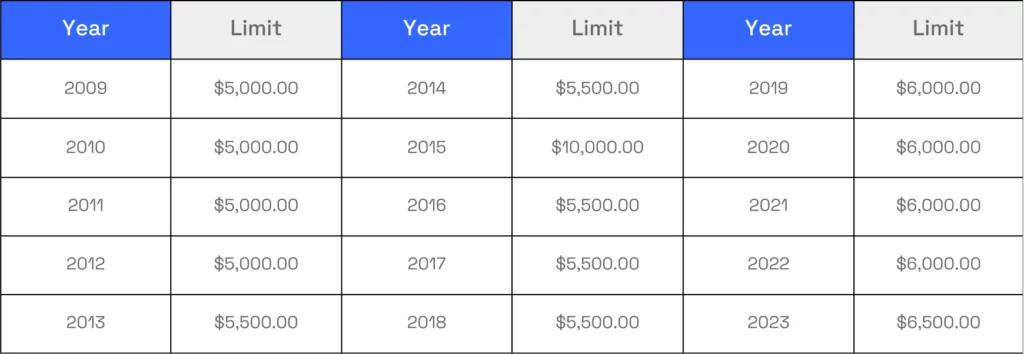In 2009, the Canadian government created Tax-Free Savings Accounts (TFSA). This type of bank account immediately became popular among Canadians as it allows people to save money without paying taxes. Reportedly, over 63% of Canadians have a TFSA.
What is a Tax-Free Savings Account?
A TFSA is a registered saving account for Canadians. It helps them save money annually without paying taxes on their earnings.
Creditpicks
A TFSA is a registered saving account for Canadians. It helps them save money annually without paying taxes on their earnings.
TFSAs are not limited to saving money. They can also be used to hold investments such as mutual funds and Guaranteed Investment Certificates (GIC). Moreover, all your savings and investments are completely tax-free when you keep them in a TFSA in Canada.
Tax-Free Savings Accounts come with several other benefits for Canadians. You can withdraw your money easily whenever you want. The contribution limit from previous years is added to the new year’s limit.
You can use a TFSA to purchase savings and investment products, like stocks and ETFs. These securities can be held in a TFSA. This flexibility helps you reach your financial goals.
How to Open a TFSA in Canada

Opening a Tax-Free Savings Account in Canada is a straightforward process. Numerous financial institutions, insurance companies, and investment firms make TFSAs available to Canadians. However, to qualify, you must meet specific criteria.
- Be a resident of Canada.
- Have a valid Social Insurance Number (SIN).
- Be 18 years or older (or the age of majority in your province).
In some provinces, 19 is the age of adulthood. Examples include Newfoundland and Labrador, New Brunswick, Nova Scotia, British Columbia, and Northwest Territories.
You can have multiple Tax-Free Savings Accounts. However, the total amount of money you can contribute is the same, no matter how many accounts you have. This whole contribution room is shared between all of your accounts.
You must complete the required steps to set up a TFSA in Canada.
- Contact your credit union, financial institution, or insurance company (the issuer company).
- Provide your SIN and birthdate to the provider to register your eligible plan as a TFSA. They may require additional paperwork.
Contributions to a TFSA
It is important to be aware of the annual TFSA contribution limit – the current limit for 2023 is $6,500. This table summarizes the TFSA contribution room for each year since its introduction in Canada.

The good news is that your remaining contribution room is added to the new year’s room. In other words, if you were eligible to contribute in previous years but did not have the money to do so, your remaining room is added to the available space for the current year.
As of 2023, the total contribution room for Canadians is $88,000. Deposits and withdrawals made in previous years should be considered when calculating your limit. Doing so will ensure an accurate result. Generally, you can use the following formula to calculate your actual contribution room:
Current year contribution limit + Unused contribution room from previous years + Withdrawals made in previous years = Currently-available TFSA room
You must record your account status to know how much room you currently have. If you put in more money than the permitted amount for your TFSA, you will be subject to a monthly penalty of 1% as long as the extra money stays in the account.
TFSA Investment Options

Tax-Free Savings Accounts and Registered Retirement Savings Plans (RRSPs) allow similar investments.
These investment types include the following options:
- Cash.
- Mutual funds.
- Stock exchange-listed securities.
- Guaranteed Investment Certificates (GICs).
- Bonds.
- Certain shares of small business corporations.
- Exchange-Traded Funds (ETFs) and index funds.
- Self-directed TFSAs and alternative investments.
Each investment option may come with its unique benefits and drawbacks. So first, consult a financial expert to choose suitable investments for you. Then, carefully consider the level of risk you are willing to take.
Advantages of Investing in a TFSA
It is highly beneficial to invest in a Tax-Free Savings Account in Canada; understanding the advantages it provides is essential.
TFSA is Tax-Free
TFSAs provide a financial benefit in that gains from investments within the account are not taxed, and withdrawals are tax-free. This makes a TFSA more attractive than RRSPs, which levy taxes on withdrawals.
TFSA Remains Forever
Unlike RRSPs, you are not obligated to take out any money from your TFSA. If you prefer to hold onto your funds, you can even pass them down after you pass away. All that needs to be done is to assign a beneficiary or a successor holder, for example, your partner.
No Effects On Other Government Benefits
Even if you receive a high income, you do not have to report any TFSA withdrawals on your tax returns. This helps your government benefits remain untouched, including Old Age Security, Guaranteed Income Supplement, Employment Insurance, and Canada Child Benefit.
TFSA is Not Income-Dependent
Everyone in Canada has the same contribution room in a year, currently $6,500 in 2023. So you can take advantage of your contribution room even if your income is very little. That is why TFSAs are great for people with modest or low incomes.
Easy Withdrawal
The money withdrawal process is as simple as filling out a form with your financial institution. There will be no tax withholding. However, it is thought by some that the ability to access your funds quickly might lead to less money being saved and fewer investment opportunities.
Growing Contribution Room
You can contribute up to $6,500 a year. If you did not contribute the total amount in the past, you can add your unused room to the current space. For example, if you just put in $1,000 in 2022, you will have up to $11,500 in the room in 2023.
Many Investment Options
Depending on your financial goals and risk tolerance, you can invest your funds in a TFSA in various vehicles, including stocks, bonds, cash, ETFs, mutual funds, and more.
Disadvantages of Investing in a TFSA
The TFSA program in Canada offers many advantages. However, there are a few drawbacks that ought to be taken into account.
Limited Contribution Room
As you already know, there is a ceiling to how much you can contribute to a TFSA. Be careful not to overcontribute, as you will face a monthly tax penalty of 1% on any excessive contribution amounts.
No Tax Deduction for Contributions
You do not get any tax breaks when you put money into a TFSA in Canada. Therefore, a Tax-Free Savings Account might not be the best choice if reducing your income tax bill is your primary goal.
How to Choose Investments for a TFSA

The best TFSA investment option depends on your financial goals and the level of risk you are willing to take. First, you need to determine clear investment goals. For example, saving $20,000.00 for a new car purchase in three years or $1 million for retirement in 25 years. Then, you can develop an investment plan to help you reach those goals.
Figure out the return you need and create a portfolio that includes a mixture of assets and savings. Then, you can seek professional financial advice for more complex investment decisions. Throughout a lifetime, small but regular contributions can add up to a significant amount of money.
You must research and compare different investment options to determine which matches your financial desires and targets. Individuals who want to save money in the short term should consider high-yield savings accounts from an online banking institution. Those aiming to save up for the long term can look into investing in ETFs. The best TFSA investments always depend on your unique situation.
Managing and Monitoring Your TFSA Investments
Managing and monitoring your TFSA investments is critical to meet your goals. Review and adjust your investments regularly. Manage your withdrawals and deposits of cash. Track your income from investments in stocks, ETFs, and mutual funds.
Moreover, tax rules and regulations constantly change, and customers must know the changes immediately. Therefore, you should keep track of tax changes to be able to take care of your investments in a TFSA in Canada.
You can use several options to manage and monitor your TFSA investments. There are some online tools you can take advantage of. These tools offer many features. For example, you can import historical trades from different brokers and track transactions from several stock exchanges. They also enable you to track Canadian mutual funds and currencies and calculate your CGT.
Not sure how to manage your TFSA investments in Canada? Get professional financial advice from experts in the field. They can help you make sure your investments are well monitored.
Conclusion
Having Tax-Free Savings Account in Canada grants you multiple advantages. Your earnings are not subject to taxes, allowing you to save the money normally taken out. Furthermore, you can pass your TFSA to your family members or significant other. It won’t affect your government benefits, like Old Age Security.
Tax-Free Savings Accounts are an ideal option for individuals with lower incomes, as they are not dependent on the amount of money you make. The process of withdrawing from these accounts is incredibly straightforward, and you can accumulate any unused contribution space from the previous year to the following one. Additionally, Canadians have a wide range of investment choices with a TFSA, such as stocks, ETFs, bonds, cash, GICs, and mutual funds.
If you are considering having a well-rounded investment plan in Canada, you should consider a TFSA as a part of it. Consult with a financial expert and start your investment today.




